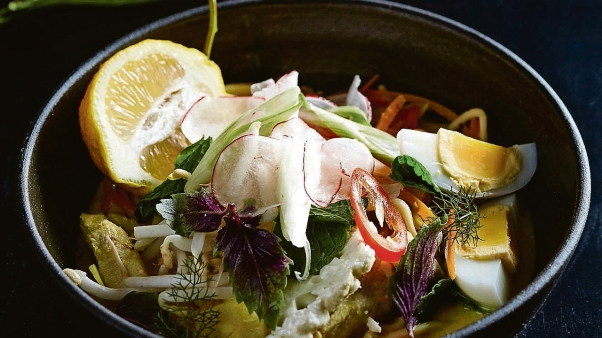Months after the Fifa 2010 World Cup, the Hemelhuijs opened on Cape Town’s freshly pedestrianised Waterkant Street, which formed part of the newly christened “fan walk”. Only open for breakfast and lunch and somewhat tucked away near the foot of the bridge that takes one over Buitengracht Street, Hemehuijs has nevertheless thrived for the past five years and built up an excellent reputation. It is also one of the city’s most attractive boutique restaurants.
Owner Jacques Erasmus has a stylish eye, and one is immediately struck by decorative similarities between Hemelhuijs and his erstwhile collaborator’s Babel at Babylonstoren, such as the photographic, A2-sized menus and the emphasis on colour when arranging the plate. Erasmus takes his restaurant environment seriously, repainting the interior with a new palate, and changing the ornamentation every few months in keeping with the seasonal menu.
Increasingly, fashionable restaurants — Chef’s Warehouse and Dear Me spring to mind — these days sell product lines. Hemelhuijs not only sells ceramic tableware, vases and lights, but also a beautifully packaged comestibles quaintly referred to as their “flavour library” collection. They offer novelties such as furikake (a Japanese seaweed and sesame seasoning), kashmiri chai (the salted almond version) and bottles of sweet, hot, Javanese long pepper.
To start, I highly recommend one of their unique juice blends that uses their own bark, seed and fruit-infused alcohols. The quince Bellini with prosecco has a lovely foamy depth and the quince and saffron ratafia made with freshly pressed apple is more refreshing than a mountain stream. Hemelhuijs, as the spelling of its name suggests, likes to play with the country’s Dutch ancestry, and the bread to start is mosbolletjies traditionally flavoured with aniseed, but served most unusually with Middle Eastern za’atar.

Gnocchi on roasted aubergine and pear purée
On the day I dined there as a guest of the establishment, the kitchen had procured some delicious, rare porcini mushrooms, and served them with quince cheese (membrillo), imported gorgonzola and rocket. The addition of pomegranate syrup seemed rather gratuitous. What a difference it makes to the dining experience to have an extremely knowledgeable waiter, in this case Brydon Furstenburg, who has been with Hemelhuijs for a while.
The soups that day gave true winter comfort — a cream of roasted cauliflower and chestnut soup, with a hint of truffle and garlic, and a little parsley cream; and a jammy, naturally sweet, slow-cooked onion soup topped with brioche and baked Kleinrivier gruyère. Both soups were served in beautiful black bowls (also for sale) on ornate blue-and-white plates — a nod to Dutch heritage. Unconventional salads are a strong point here — think of aubergine caviar, chermoula hummus, baby beetroots and candied walnuts.
After some deliberation, I went with the maple baked parsnip salad, with parsnips still warm, accompanied by whipped herb cheese, navel orange cross-sections, prunes and mustard. It looked dashing, but sometimes the whole is not made greater by the sum of its parts; the prunes seemed to subtract a little rather than add to this dish. A good sequel to this was the ?gnocchi. Now, I seldom order gnocchi, which has nothing to do with Tim Noakes and everything to do with them usually being like swallowing lead bullets, but these hand-made gnocchi were light and flavourful, joyously companioned with roasted aubergines, pear purée and black truffle cream.
For mains, the white fish was angel fish, which easily dries out, but this fillet was perfectly prepared. The dish had a strong South East-Asian influence, served in a deep bowl with Ceylon spices, coconut milk, noodles, palm hearts, shoots, radishes, shredded carrot and the presence of a halved boiled egg looking up at one. For dessert, there was only just enough room left for a slice of cinnamon apple tart topped with crème fraiche — delicious enough to lick the plate, and if that isn’t enough, you can buy the plate too.
First published in the Mail & Guardian 7 September 2015.

